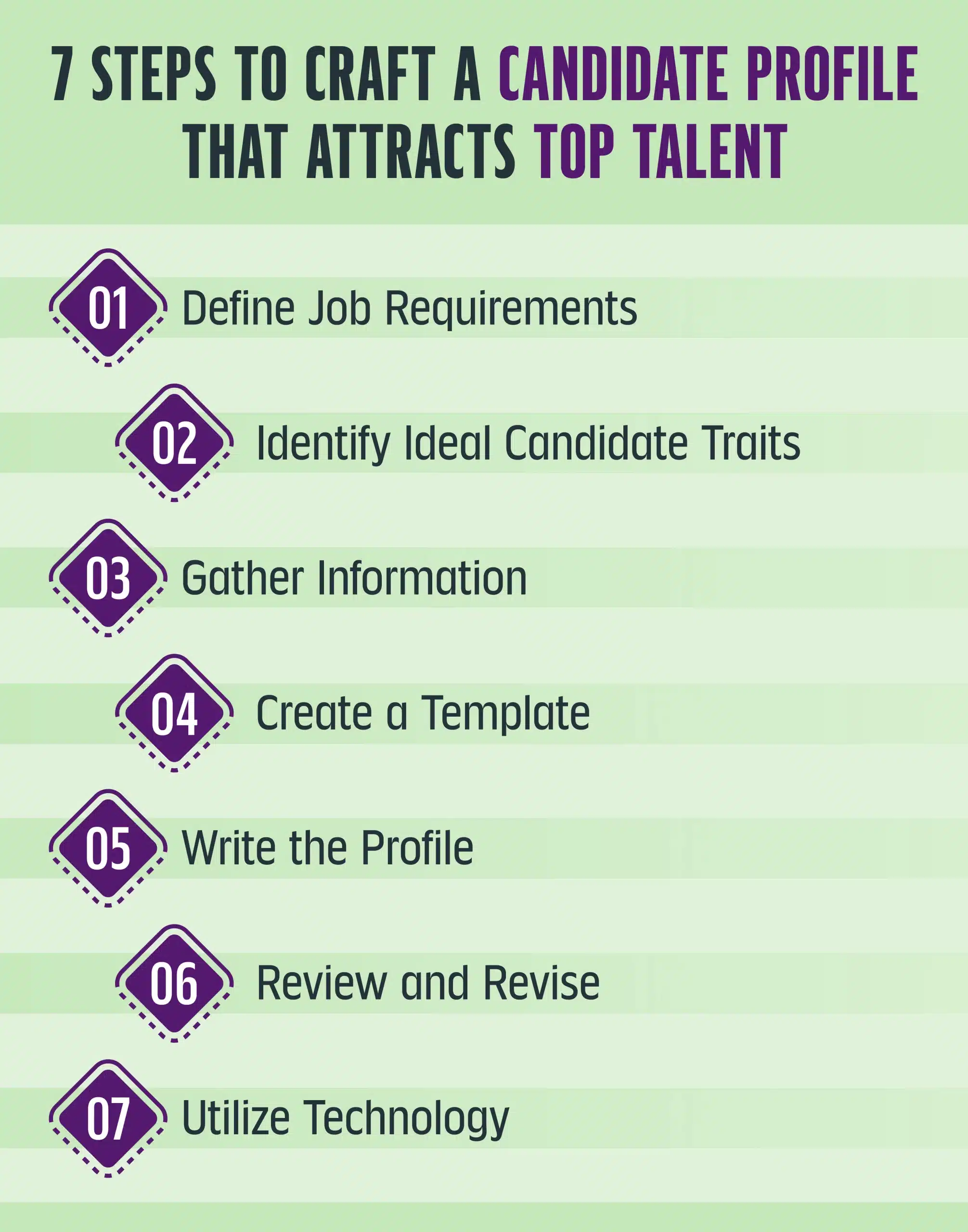Table of content
In this blog, we’ll explore how creating an ideal candidate profile can revolutionize your recruitment process, leading to higher quality of hires and better candidate-job fit. Let’s delve into how candidate profiling saves time and improves hiring outcomes.
What is an Ideal Candidate Profiling?
A candidate profile is more than just a simple list of qualifications. It’s a detailed snapshot of an individual’s professional background, skills, experiences, and personal attributes tailored to a specific job role. Unlike a traditional resume, which may only scratch the surface, a candidate profile delves deeper into a candidate’s suitability for the position by considering factors such as cultural fit and alignment with organizational values. It provides recruiters with a comprehensive overview of a candidate’s potential contribution to the team and the company.
The Essential Elements of a Stellar Ideal Candidate Profile
A strong candidate profile acts as a roadmap, guiding you toward attracting the perfect person for the job. Here’s a breakdown of the key elements you need to consider:
- Essential Skills & Experience: This forms the core of your profile. Identify the technical skills and experience necessary to succeed in the role. Be specific—list software proficiency, relevant certifications, and years of experience required.
- Desired Skills & Experience: While some skills are non-negotiable, others can be considered “nice-to-haves.” Use this section to list additional skills or experience that would benefit the role. This could include specific programming languages, project management experience, or industry knowledge.
- Educational Background: Outline the minimum and preferred educational qualifications for the position. Be flexible if specific degrees are not essential for success, but do define the level of education (e.g., Bachelor’s degree, relevant coursework).
- Work Style & Personality Traits: A great fit goes beyond technical skills. Describe the ideal work style for the role (independent, collaborative, detail-oriented) and desired personality traits (strong communication, problem-solving skills, team player).
- Career Goals & Values: Understanding a candidate’s career aspirations is crucial. Highlight the type of career growth and development opportunities you offer. Additionally, consider the company values and mission and identify candidates whose values align with yours.
How Candidate Profiling Streamlines Your Hiring?
Candidate profiling isn’t just a fancy term – it’s a game-changer for your recruitment process. Here’s how it streamlines your efforts and leads to better hires:
- Targeted Sourcing: Candidate profiling allows you to identify specific skills, experience, and qualifications crucial for the role. This empowers you to target your sourcing efforts, attracting candidates who are a strong fit. No more wasted time on irrelevant applications!
- Streamlined Screening: Candidate profiles go beyond surface-level information, providing a deeper understanding of the candidate’s suitability. With clear criteria in your profile, screening resumes become faster and more efficient. You can quickly assess if a candidate possesses the essential skills and experience outlined in your candidate profile.
- Improved Interview Focus: Gone are the days of generic interview questions. By leveraging your candidate profile, you can tailor your interview questions to delve deeper into the most important aspects. This allows you to assess technical skills, cultural fit, work style, and problem-solving abilities – all crucial elements in your candidate profile.
- Informed Hiring Decisions: Making hiring decisions can be complex. Candidate profiles act as a benchmark, providing a clear picture of the ideal candidate. When comparing applicants, you can objectively assess who best aligns with the defined criteria in your candidate profile. This data-driven approach reduces hiring bias and ensures you make the best choice for your team.
- Reduced Time-to-Hire: The traditional recruitment process can be lengthy. By attracting the right talent with targeted sourcing and streamlining screening, candidate profiling significantly reduces the time it takes to fill a position. You’ll spend less time wading through applications and more time interviewing qualified candidates, leading to a faster time to hire.
- Enhanced Employer Branding: A well-crafted candidate profile goes beyond just attracting talent; it showcases your company culture and values. By highlighting the qualities you seek in a candidate, you’re telling potential hires what it’s like to work for your company. This transparency attracts candidates who are a good cultural fit, strengthening your employer branding.
Candidate profiling is a powerful tool transforms your recruitment process from a guessing game into a strategic approach. By clearly outlining your ideal candidate, you attract top talent, improve your hiring decisions, and ultimately build a dream team for your company.
7 Steps to Craft a Candidate Profile That Attracts Top Talent
Crafting a compelling candidate profile requires a systematic approach combining creativity and strategic thinking. Here’s a detailed breakdown of the essential steps:
- Define Job Requirements: Begin by conducting a thorough analysis of the job role, identifying the specific skills, experiences, and qualifications necessary for success.
- Identify Ideal Candidate Traits: Consider the soft skills, personality traits, and cultural attributes essential for thriving in the organization’s unique environment.
- Gather Information: To inform the candidate profile, collect relevant data from various sources, including job descriptions, input from hiring managers, and industry benchmarks.
- Create a Template: Develop a standardized template or format for organizing candidate information, ensuring consistency and clarity across profiles.
- Write the Profile: Use the gathered information to craft a compelling narrative highlighting the candidate’s strengths, experiences, and suitability for the role.
- Review and Revise: Seek feedback from key stakeholders, such as hiring managers and team members, to refine the candidate profile and ensure alignment with hiring objectives.
- Utilize Technology: Leverage advanced recruitment tools and technologies, such as applicant tracking systems and AI-driven analytics, to streamline the creation and management of candidate profiles, enhancing efficiency and effectiveness.
Conclusion
Candidate profiling is a cornerstone of modern recruitment practices, offering a strategic framework for identifying, evaluating, and selecting top talent. By creating comprehensive candidate profiles that encompass both technical qualifications and soft skills, recruiters can streamline the hiring process, improve the quality of hires, and foster a culture of excellence within their organizations. By following the steps outlined above and leveraging the latest recruitment technologies, recruiters can unlock the full potential of candidate profiling and drive sustainable success in talent acquisition.



